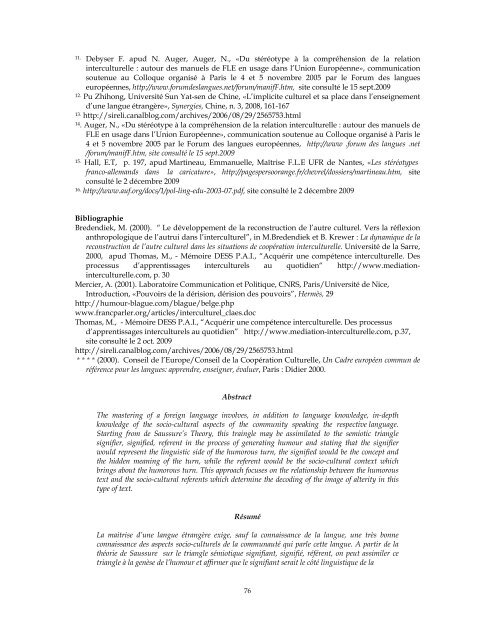You also want an ePaper? Increase the reach of your titles
YUMPU automatically turns print PDFs into web optimized ePapers that Google loves.
11. Debyser F. apud N. Auger, Auger, N., «Du stéréotype à la compréhension <strong>de</strong> la relation<br />
interculturelle : autour <strong>de</strong>s manuels <strong>de</strong> FLE en usage dans l’Union Européenne», communication<br />
soutenue au Colloque organisé à Paris le 4 et 5 novembre 2005 par le Forum <strong>de</strong>s langues<br />
européennes, http://www.forum<strong>de</strong>slangues.net/forum/manifF.htm, site consulté le 15 sept.2009<br />
12. Pu Zhihong, Université Sun Yat-sen <strong>de</strong> Chine, «L’implicite culturel et sa place dans l’enseignement<br />
d’une langue étrangère», Synergies, Chine, n. 3, 2008, 161-167<br />
13. http://sireli.canalblog.com/archives/2006/08/29/2565753.html<br />
14 . Auger, N., «Du stéréotype à la compréhension <strong>de</strong> la relation interculturelle : autour <strong>de</strong>s manuels <strong>de</strong><br />
FLE en usage dans l’Union Européenne», communication soutenue au Colloque organisé à Paris le<br />
4 et 5 novembre 2005 par le Forum <strong>de</strong>s langues européennes, http://www .forum <strong>de</strong>s langues .net<br />
/forum/manifF.htm, site consulté le 15 sept.2009<br />
15. Hall, E.T, p. 197, apud Martineau, Emmanuelle, Maîtrise F.L.E UFR <strong>de</strong> Nantes, «Les stéréotypes<br />
franco-allemands dans la caricature», http://pagespersoorange.fr/chevrel/dossiers/martineau.htm, site<br />
consulté le 2 décembre 2009<br />
16. http://www.auf.org/docs/1/pol-ling-edu-2003-07.pdf, site consulté le 2 décembre 2009<br />
Bibliographie<br />
Bre<strong>de</strong>ndiek, M. (2000). “ Le développement <strong>de</strong> la reconstruction <strong>de</strong> l’autre culturel. Vers la réflexion<br />
anthropologique <strong>de</strong> l’autrui dans l’interculturel”, in M.Bre<strong>de</strong>ndiek et B. Krewer : La dynamique <strong>de</strong> la<br />
reconstruction <strong>de</strong> l’autre culturel dans les situations <strong>de</strong> coopération interculturelle. Université <strong>de</strong> la Sarre,<br />
2000, apud Thomas, M., - Mémoire DESS P.A.I., “Acquérir une compétence interculturelle. Des<br />
processus d’apprentissages interculturels au quotidien“ http://www.mediationinterculturelle.com,<br />
p. 30<br />
Mercier, A. (2001). Laboratoire Communication et Politique, CNRS, Paris/Université <strong>de</strong> Nice,<br />
Introduction, «Pouvoirs <strong>de</strong> la dérision, dérision <strong>de</strong>s pouvoirs”, Hermès, 29<br />
http://humour-blague.com/blague/belge.php<br />
www.francparler.org/articles/interculturel_claes.doc<br />
Thomas, M., - Mémoire DESS P.A.I., “Acquérir une compétence interculturelle. Des processus<br />
d’apprentissages interculturels au quotidien” http://www.mediation-interculturelle.com, p.37,<br />
site consulté le 2 oct. 2009<br />
http://sireli.canalblog.com/archives/2006/08/29/2565753.html<br />
* * * * (2000). Conseil <strong>de</strong> l’Europe/Conseil <strong>de</strong> la Coopération Culturelle, Un Cadre européen commun <strong>de</strong><br />
référence pour les langues: apprendre, enseigner, évaluer, Paris : Didier 2000.<br />
Abstract<br />
The mastering of a foreign language involves, in addition to language knowledge, in-<strong>de</strong>pth<br />
knowledge of the socio-cultural aspects of the community speaking the respective language.<br />
Starting from <strong>de</strong> Saussure’s Theory, this traingle may be assimilated to the semiotic triangle<br />
signifier, signified, referent in the process of generating humour and stating that the signifier<br />
would represent the linguistic si<strong>de</strong> of the humorous turn, the signified would be the concept and<br />
the hid<strong>de</strong>n meaning of the turn, while the referent would be the socio-cultural con<strong>text</strong> which<br />
brings about the humorous turn. This approach focuses on the relationship between the humorous<br />
<strong>text</strong> and the socio-cultural referents which <strong>de</strong>termine the <strong>de</strong>coding of the image of alterity in this<br />
type of <strong>text</strong>.<br />
Résumé<br />
La maitrise d’une langue étrangère exige, sauf la connaissance <strong>de</strong> la langue, une très bonne<br />
connaissance <strong>de</strong>s aspects socio-culturels <strong>de</strong> la communauté qui parle cette langue. A partir <strong>de</strong> la<br />
théorie <strong>de</strong> Saussure sur le triangle sémiotique signifiant, signifié, référent, on peut assimiler ce<br />
triangle à la genèse <strong>de</strong> l’humour et affirmer que le signifiant serait le côté linguistique <strong>de</strong> la<br />
76












